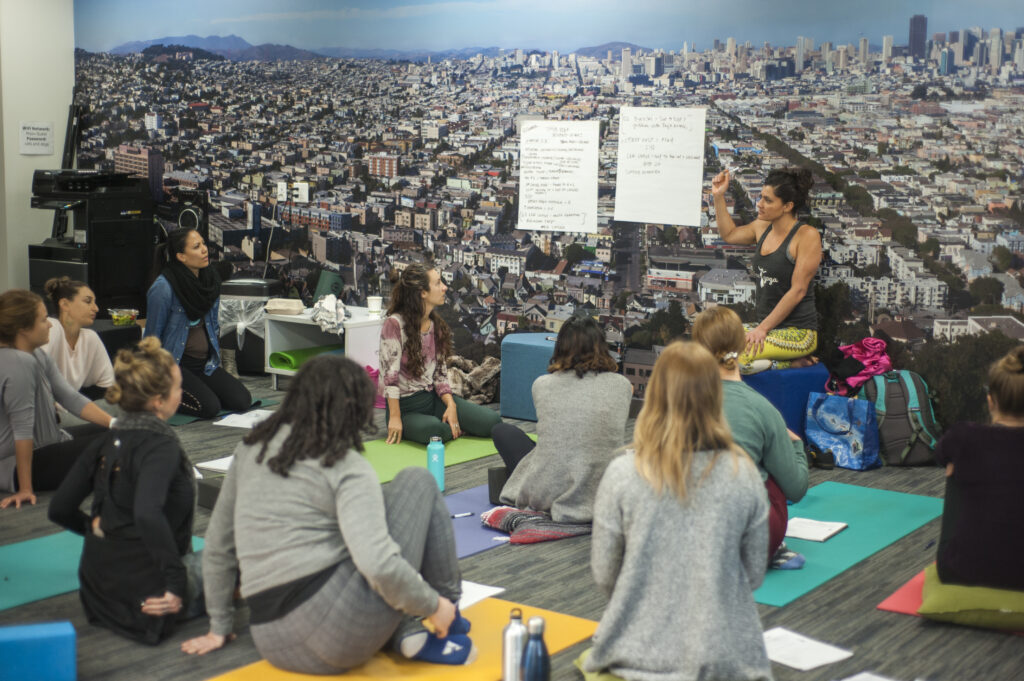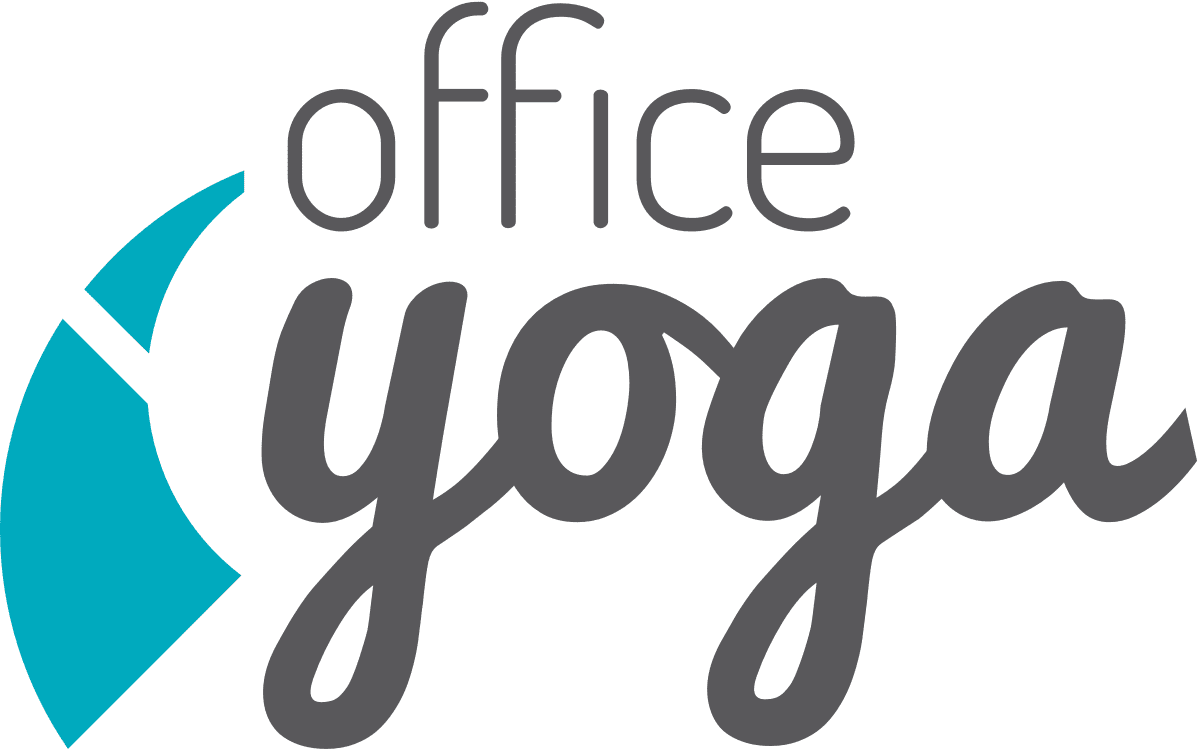How to Become a Successful Corporate Yoga Teacher

Interested in becoming a corporate yoga teacher? Get practical tips in our monthly newsletter!
Teaching corporate yoga continues to pique the interest of many instructors. However, the blueprint for navigating the corporate yoga world remains unwritten. As a corporate yoga teacher and Founder of Office Yoga, I’ve made every mistake, so you don’t have to repeat them. Below, I share the seven critical ingredients to becoming a successful corporate yoga teacher in hopes of making your journey smoother than mine.
1. Start Acting Like a Small Business Owner (because you are!)
Instead of thinking of yourself as a yoga teacher, think of yourself as a small business that offers yoga services. You are in the B2B market, business-to-business, so you are a business owner on paper. Whether you are a sole proprietor offering classes under your name or you have a brand under an LLC, you are a small business owner.
Three things happen when you think this way: first, you separate yourself from your work. You no longer identify as the product; instead, you are a distributor of the product. Think of a moment in meditation when you realize you are not your thoughts. It’s very liberating!
Second, you begin to think of your corporate clients as partners. Company A wants to create a healthy workplace culture, and they hired your business, Company B, for yoga services. Strategic alliances are always mutually beneficial. The more time you spend with Company A, the more you will understand their culture and be able to offer different yoga services to boost employee health and company culture.
Lastly, separating yourself from your business makes developing a business plan and marketing strategy easier. The newsletter from your local coffee shop may inspire your company newsletter. Watching the boutique gym expand and grow will give you insight into strategies for increasing your business. Confidently step into the shoes of being the CEO of your company, and your perspective (and business) will grow.
2. Think Outside the Studio Box
Sharing the Desk Yoga format is the most significant AHA moment I have with students in Office Yoga Training. Accessible formats are my expertise and where I can help you the most. Many corporate yoga teachers make a big mistake by only offering flow-style mat classes, in which employees must bring mats, change their clothes, and get sweaty. Changing clothes wastes precious work time, and many employees are uncomfortable wearing yoga clothes in front of their coworkers or bosses. Flow-style classes take over an hour from an employee’s workday and exclude most beginners or shy employees.
Desk Yoga creates an inclusive workplace environment for three reasons. First, employees can do Desk Yoga in their work clothes, saving time. Second, employees are comfortable sitting around a conference table, so the environment is familiar and attainable. Lastly, you can teach the session in 20- or 30-minute increments, accommodating a busy work day. Seeing the lightbulbs go off in teachers’ minds when I share the Desk Yoga practice in training brings me immense joy and satisfaction.
Once you begin to think outside the studio box, the way to provide yoga workshops, talks, and seminars becomes clearer. You can create themes that relate to the client and industry. The creative spirit that lives within a yoga teacher begins to shine here!
3. Get Familiar with the Corporate Yoga Industry
Yoga is thousands of years old, but corporate yoga only started in the eighties. Yoga in the office took off in the early 2000s and hit another turning point during the COVID-19 pandemic. Business cycles have natural periods of expansion and recession, also called peaks and troughs. As a lifelong entrepreneur, the best advice I can offer for long-term success is to plan and prep during economic recessions so you can shine when the economy begins to peak.
We don’t control economic peaks and troughs, but we can control our understanding of the market and how best to offer yoga to our customers.
When working with clients, the company’s size and industry are two components to consider. Proposing an annual yoga package with five weekly classes to a mom-and-pop shop will be overkill, and suggesting a starter series to an enterprise company will not be enough. Company sizes can be divided into mom-and-pop (1-9 employees), small companies (10-49 employees), medium-sized companies (50-249 employees), large companies (250-999 employees), and enterprise companies (1,000+ employees). The company’s size will impact the wellness budget and services needed for employees’ health and well-being.
Your client’s industry will impact yoga services. The healthcare industry was under pressure when the COVID-19 pandemic started in the United States. One of my clients, a biotech company, released the first rapid test consumers could take. The six months leading up to that were very high pressure for employees, and taking an hour for yoga was impossible. We switched to 20-minute desk yoga practices twice weekly to meet their needs.
Industries include technology, financial services, healthcare, legal services, non-profit, education, entertainment, transportation, government, hospitality, retail, and manufacturing. Understanding the client’s industry and needs will help you provide the best services possible.
4. Grow Your Client Base

Subscribe here and be the first to receive Office Yoga inspiration!
The most common discomfort I hear from teachers is that they feel too shy or intimidated to promote themselves. Stress in the corporate environment is palpable, and employees need your yoga services; what you have to offer is a powerful remedy. When growing your client base, you’re promoting the benefits of yoga, not yourself.
Use Linkedin as your social media platform instead of Instagram or TikTok. LinkedIn is a professional social media platform specifically designed for hiring professionals. In my thirteen years of experience, I’ve never gotten a corporate client from Instagram. Know where your audience finds their information and promote your services there. An email list is far more effective than social media. Use social media to share small snippets about your services, leading them to an article or podcast in your newsletter.
Another common mistake teachers face is consistency. Your client base will be more consistent when you are consistent in your marketing. Have a regular cadence of social media posts, newsletters, and content to share. When your audience hears you repeat the same message time and time again, it will begin to resonate that YOU are the go-to person.
5. Understand Seasonal Cycles

Want to learn more about Office Yoga? Subscribe to receive our free monthly newsletter!
Company cycles fall into two categories: external and internal. External ones are guided by national seasons and holidays, while internal cycles are guided by the industry. A retail company will get busy during the holiday season, while an education company will peak during the back-to-school season. Knowing your client’s industry will give you insight into when employees will have higher demands and stressors.
Human resource departments will replenish their budgets during open enrollment, so keep this in mind when working with your clients. Open enrollment varies for each company, but standard calendar dates are January 1 or July 1. Make a note to discuss program options in advance to budget for the proceeding year.
6. Adapt to Industry Changes
Staying informed about industry developments is critical to long-term success. Many entrepreneurs have great business ideas that meet the moment but don’t know how to adapt to industry changes. Blockbuster was in every big city nationwide, but it didn’t know how to adjust to the digital era. People didn’t stop watching movies; they changed the medium in which they watched content. Three ways to stay relevant as a corporate yoga teacher include teaching short-form content, learning to teach hybrid formats, and teaching small, simple concepts. I learned to make these changes as the Founder of Office Yoga, and this is another area I can support you the most.
Short-Form Classes: Office workers don’t have the luxury of taking an hour out of the day to practice yoga. Short-form classes allow the practice to be accessible. A twenty-minute desk yoga session enables the employee with a 12:30 lunch call to participate. A ten-minute meditation may be all the time someone has to slip away on a busy day. Learn how to teach short-form classes to make your services accessible to all employees.
Hybrid Format: The pandemic gave rise to the hybrid workforce. Many companies have a combination of on-site and remote workers. Learn to offer your services onsite and online. Our Office Yoga Training curriculum outlines a few ways to do this. The best place to start is to provide both options and allow the client to choose. Human resources departments balance keeping on-site and remote employees happy, and knowing that you do both will make their lives easier and your business more successful!
Simple Concepts: A little goes a long way in corporate yoga. If you only have twenty minutes, don’t recite the entire Yoga Sutras in one sitting. Think of each session as an opportunity to teach one straightforward concept. A class focus can be spinal extension, 4-count breath, or contentment. Whatever you decide to teach, repeat the teaching point again and again.
7. Get a Corporate Yoga Education

Interested in Office Yoga Training? Click here to learn more.
The yoga community has evolved from creating 200-hour to 800-hour training programs for teachers to learn. Short-form training modules like prenatal yoga, restorative yoga, yoga for kids, and other specifications have splintered off into continuing education programs. Corporate yoga programs have yet to spread widely, which is unfortunate because the corporate environment is litigious and requires highly skilled instructors.
Find a program that offers extensive corporate yoga training to ensure you’re offering the safest services to your clients. I have an Office Yoga Training program certifying 16-24 instructors annually. Our values and teaching points provide accessible formats for all employees and incorporate yoga principles into business practices. I cap our program at 12 students twice a year to maintain safety and quality assurance and give each student my full attention. Find a program that aligns with your values and who you want to be as a corporate yoga instructor.
Transitioning into the corporate yoga space can feel overwhelming. Approach it with a beginner’s mindset and focus on one ingredient at a time that resonates with you. Embodying these lessons will help you avoid common pitfalls and guide you to success as a corporate yoga teacher. Educate yourself in this field and enjoy the process!
Office Yoga certifies instructors to teach corporate yoga. Click here to learn more.
